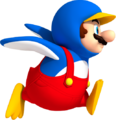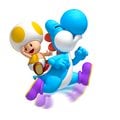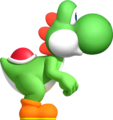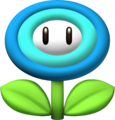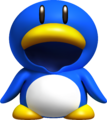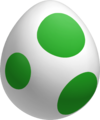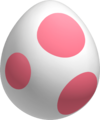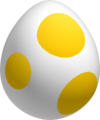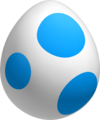New Super Mario Bros. Wii
Template:Infobox New Super Mario Bros. Wii is a sidescrolling Mario game for the Wii, and has been released in Australia on November 12; in America on November 15, and Europe on November 20 of the year 2009. It is the follow-up to New Super Mario Bros., a 2006 game released for the Nintendo DS. In addition to the single-player experience, the game also features a multiplayer mode for up to four players. It features more items, new levels and more enemies than the DS predecessor. It's also the first title to support Nintendo's new Super Guide[1] mode.
Story
It is Princess Peach's birthday and as Mario and his friends are celebrating. However, a huge cake reels in. Immediately, Bowser Jr. and the Koopalings pop out and throw the giant cake on top of Peach, trapping her. From there, the villains load her onto their ship while Mario, Luigi, Blue Toad and Yellow Toad follow closely. The Toads from the castle soon use a cannon to blast away the Propeller and Penguin suit towards Mario and the others so they can have access to them.[2] Template:Spoiler When Mario and the gang finally get to the final castle, they find none other than Bowser himself. One of them has to jump on the button to defeat Bowser, sending him falling into the lava below. After, Mario, Luigi, Yellow Toad, and Blue Toad celebrate their victory, they see Peach crying in a cage. However, she turns out to be Kamek in Peach's dress. Kamek then powers Bowser up, ten times his normal size. After Bowser has been powered up, the four can do nothing but flee from the giant boss. Soon they find a dead end with a huge button. They push it, and the giant Bowser falls into the lava again. Just then, Princess Peach is released from her cage, and the two set off, out of the castle. As they venture out, they see Luigi, Blue Toad and Yellow Toad arrive in their hot air balloons. Luigi lets Mario and Peach into his balloon and is accidentally left behind. The two Toads then offer Luigi a ride in their balloon. As they sail off, Peach asks Mario if she told him about the Secret World.
After the credits, Larry Koopa is seen limping toward Bowser's Castle. He meets Bowser Jr., who shows Larry the rest of the Koopalings trying to push the giant Bowser right side up. They finally succeed, with a huge thud, causing the castle to fall on top of Bowser and his eight children.[3]
Template:Endspoiler
Gameplay Features
The regular mode of the game can be played in single-player or multiplayer cooperative mode. Players can be freely added and removed between levels. As in Super Smash Bros. games, the camera zooms out when players move farther away from the screen. However, there is a limit and players who are far behind can still be kicked out of the screen. When a player dies or even falls into a pit, he reappears in a bubble. Other players can burst that bubble to allow the reappearing player to continue playing, or they can wait to be able to collect more power-ups for themselves. ? Blocks usually create one item for each player - for example, a block produces four mushrooms when four players are playing. Players can cooperate by picking each other up. Also, Blue Toad and Yellow Toad are playable in multiplayer.
When one player grabs the flagpole at the end of the level, the other players have about three seconds to grab it as well if they want to score points with it. If they don't catch it in time, the level still ends. After that, players get a tally telling players how many coins they have collected and how many enemies they have defeated. The players are ranked according to those points.
The basic style of the game resembles New Super Mario Bros. on the Nintendo DS. Players can collect Star Coins and find secret pipes. Parts of the ground can move.
Players play the game holding the Wii Remote sideways. Tilting the Wii Remote, as well as shaking can activate certain items, such as changing the direction of a light, tilt platforms or using the Propeller suit.
According to Vol. 248 of Nintendo Power Magazine and Gamestop it is possible to play with a Nunchuk controller attached.
It's possible to ride on Yoshi as well.[4] Yoshi can swallow many different objects in the game including hammers thrown by Hammer Bros. and fireballs shot by somebody with a Fire Flower as well as iceballs shot by a player wielding an Ice Flower. Yoshi can then throw those objects around. Yoshi can also take and carry other players in his mouth for a short period of time and use his Flutter Jump, a move of his first introduced in Super Mario World 2: Yoshi's Island, to float briefly in the air. When a different player does a Ground Pound on a player who is riding a Yoshi, the Yoshi will be taken over[5]. Yoshi also has the ability to swallow apples throughout the course; if Yoshi eats a certain amount of apples, the player gets a reward. However, if the players reach the end of the level while riding on their Yoshis, they would have to leave their mounts behind. Basically, this means that there are only certain levels in which players can ride Yoshis[6]; this is similar to how the animal buddies worked in Donkey Kong Country. The Spin Jump from Super Mario World returns.[7]
On the map screen, pressing 1 allows the player to go to a screen where items from Toad houses and extra items can be used (like in Super Mario Bros. 3). Unlike New Super Mario Bros. and Super Mario World, the player can't activate items during levels. Pressing - (minus) on the map allows the player to go to any previously visited world.[8]
Super Guide
Also premiering in the game is a new feature named Super Guide. The Super Guide provides unsuccessful players assistance to clear levels. When a player has failed to pass a level at least eight times, a green box will appear at the start of the level. When the player hits the green box, the level will restart in auto-pilot mode: a computer-controlled Luigi will play the level on his own. The Super Guide will only show the player how to beat the level, but not use short-cuts or reveal secrets. While the Super Guide is running, the player can press a button on the Wii Remote at any time to take control back; the game will start exactly where the Super Guide left off. Once the player has taken control back, he or she can not turn it back on in the middle of the level. The level will still count as beaten even when the Super Guide assistance is used.[1]
Levels
The game will have nine worlds[9], that will all have a world map just like in New Super Mario Bros. There will still be Toad Houses and Towers and castles. Enemies will also patrol in the overworld.
Once a level is beaten, players can return to it for a special mission to rescue a kidnapped Toad[9] and carry him to the level exit.
Other than the game's main campaign, which can be played with up to four players, New Super Mario Bros. Wii offers special multiplayer challenges. Those challenges have some levels taken from the campaign, and some newly created levels. There is a Free for All mode and a Coin Battle mode. Free for All mode has players competing for a high score, while Coin Battle mode has them competing for the most collected coins in the level[9].
World 9 (Rainbow Path) is unlocked after completing the game. There are 8 stages in that world, and each stage is unlocked by collecting all the Star Coins in one of the 8 normal worlds.
Worlds
- World 1 - Mushroom Plains
- World 2 - Sea of Sand
- World 3 - Penguin Playground
- World 4 - Sparkle Ocean
- World 5 - Toxic Forest
- World 6 - Stone Head Mountains
- World 7 - Cloud Castle Courtyard
- World 8 - Bowser's Volcano
- World 9 - Rainbow Path (Bonus World)[10][3]
Development
According to Nintendo, Shigeru Miyamoto had been struggling to add multiplayer in a Mario game for a long time. He further explained that Miyamoto tried to experiment with multiplayer aspects at the start of most of his Mario projects. This can be seen in beta screenshots of games such as Super Mario 64 DS and New Super Mario Bros., as multiplayer aspects were evidently intended for both of those games during the earlier stages of development. But when the experiments with multiplayer failed to come to fruition, the developers focused back to what they were used to, single-player. One of the reasons this was not achieved previously was due to technical limitations. With the Wii's hardware, it allowed Miyamoto to make sure the game had all the items and enemies in the screen at once, and having the camera focusing on all the players at once.[11]
Additionally, Nintendo is planning to add the new "demo play" feature to their future titles, with New Super Mario Bros. Wii being the flagship title for the feature. A patent on the game, then called "Kind Code", was filed by Miyamoto on June 30, 2008. It showed that it could come in three modes: Game (in which the player plays the game normally until they get stuck, at which point they can view a video that appears on the screen's top right corner on how to bypass the situation in question), Digest (in which the player watches the developers play through the game until the player decides to join the game at a particular point; the game cannot be saved in this mode), and Scene Menu (where players go directly to specific parts of the game without loading their games or watching the digest). In the final game, the Digest version of the "demo play" mode was released as "Super Guide".[12]
Characters
- Mario
- Luigi
- Blue Toad
- Yellow Toad
- Yoshi (rideable, Green, Yellow, Pink and Light Blue.)
- Princess Peach
- Bowser[13]
- Koopalings[9]
- Larry Koopa - World 1[14]
- Roy Koopa - World 2[14]
- Lemmy Koopa - World 3[14]
- Wendy O. Koopa - World 4[15]
- Iggy Koopa - World 5[15]
- Morton Koopa Jr. - World 6[15]
- Ludwig von Koopa - World 7[15]
- Bowser Jr.[16][9][14]
- Kamek[14]
- Toad (red spots and blue vest)[17]
- Jumbo Rays
- Bonecoasters
Enemies
Bosses
- World 1
- Larry Koopa - Tower boss
- Larry Koopa - Castle boss
- Goombas - Enemy Course enemies
- World 2
- Roy Koopa - Tower boss
- Roy Koopa - Castle boss
- Spinies - Enemy Course enemies
- World 3
- Lemmy Koopa - Tower boss
- Lemmy Koopa - Castle boss
- Ice Bros. - Enemy Course enemies
- World 4
- Wendy O. Koopa - Tower boss
- Wendy O. Koopa - Castle boss
- Bowser Jr. - Airship boss
- Porcu-Puffer - Enemy Course enemy
- World 5
- Iggy Koopa - Tower boss
- Iggy Koopa - Castle boss
- Stalking Piranha Plants - Enemy Course enemies
- World 6
- Morton Koopa Jr. - Tower boss
- Morton Koopa Jr. - Castle boss
- Bowser Jr. - Airship boss
- Bullet Bills - Enemy Course enemies
- World 7
- Ludwig Von Koopa - Tower boss
- Ludwig Von Koopa - Castle boss
- Lakitu - Enemy Course enemies
- World 8
- Kamek - Tower boss
- Bowser Jr. - Airship boss
- Podoboos - Enemy Course enemies
- Bowser - Bowser's Castle boss
Normal Enemies
- Goombas
- Paragoombas
- Micro Goombas
- Grand Goombas
- Koopa Troopas
- Koopa Paratroopas
- Piranha Plants
- Super Piranha Plants
- Venus Fire Traps
- Super Venus Fire Traps
- Stalking Piranha Plants
- River Piranha Plants
- Munchers
- Wigglers
- Mega Wigglers
- Spikes
- Stone Spikes
- Chain Chomps
Ground Enemies
Ghost Enemies
- Boos
- Big Boos
- Broozers
- Little Mousers
- Flying Ghost Vases
Artillery Enemies
Fire Enemies
Water Enemies
- Bloopers
- Blooper Nannies
- Baby Bloopers
- Fishbones
- Spiny Cheep-Cheeps
- Cheep-Cheeps
- Mega Cheep-Cheeps
- Deep-Cheeps
- Mega Deep-Cheeps
- Cheep-Cheep Schools
- Porcu-Puffers
- Urchins
- Mega Urchins
- Clams
- Jellybeams
- Bulbers
- Cheep-Chomps
Desert Enemies
Ice Enemies
Castle Enemies
- Dry Bones
- Super Dry Bones
- Thwomps
- Super Thwomps
- Ball 'n' Chains
- Mecha-Koopas
- Amps
- Black Spiked Balls
- Giant Spike Pillars
Various Enemies
- Hammer Bros.
- Fire Bros.
- Boomerang Bros.
- Sledge Bros.
- Ice Bros.
- Huckit Crabs
- Bramballs
- Foos
- Fuzzies
- Mega Fuzzies
- Crowbers
Mini-games
Blocks
- ? Blocks
- Bricks
- Line-Guided ? Blocks
- Line-Guided Bricks
- Giant yellow block with random items
- Super Guide Blocks
- White-Green Checkered Blocks (Like a Note Block)
- POW Block [18]
- Glow Blocks
- Red Blocks (activated when hitting the red switch)
- White Smile Blocks
- Propeller Blocks
- Flying ? Blocks
- Big ? Blocks
Items
- Mushroom
- Mini Mushroom[19]
- Propeller Mushroom
- Penguin Suit[4]
- Fire Flower[4]
- Ice Flower[19]
- Coin
- Coin Bubble
- Dash Coin
- Red Ring
- Red Coin
- Blue Coin
- Star Coin
- Star
- Berries
- Barrel
- Tilt Lift
- 1-Up Mushroom
- Toad Balloon
- P-Switches
- Springboards
- Donut Lifts
- Midway Point
- Beanstalk
- Red Spikes (destroyed by fireball or iceball)
- Frozen Coin Block
- Hero Car
- Giant Bubble
- Red Switch
References to Other Games
- Mario Bros.: The POW Block reappears and has the same design as in Mario Bros. One underground Coin Battle area (pictured below) also shows some resemblance to the Mario Bros arena.
- Super Mario Bros.: The secret "Level Clear" tune is taken from this game. The first tunes from the overworld theme is played during the beginning of the Staff Roll. The Toy Time Galaxy, which is a remix of the main theme, is once again remixed and used for the minigames. World 1-1 from that game is also recreated as the second Coin Battle level, but with a few twists, such as moving coins and self-rearranging blocks. Near the beginning of the game, Bowser Jr. states in a letter that he ordered his minions to stuff every Toad they see into a ? Block which might be a reference to the fact that Bowser transformed them into ? Blocks according to the instruction book.
- Super Mario Bros. 2: Mario, Luigi, and the two Toads' ability to hold and throw POW Blocks (and some other items) came from this game.
- Super Mario Bros.: The Lost Levels: Roy Koopa's Castle has three way corridors only one of which is the correct path. This puzzle mimics many of the later castles in this game.
- Super Mario Bros. 3: The Penguin Suit is based on the suits in this game. The Koopaling battle theme is remixed twice and once again played when fighting against them. The airship theme is remixed twice and plays on the airships. The design on the Fortress is based on the Fortress sprite in this game. The Enemy Courses are similar to the levels when fighting against a Hammer Bro., Fire Bro., Boomerang Bro. or Sledge Bro. and even use a remix of that song.
- Super Mario World: The design on the Fortress-doors leading to the boss is noticeably similar. Yoshis reappear and are rideable.
- Donkey Kong Country: Players could only use the animal buddies in specific levels; Donkey Kong and Diddy Kong end up ditching their animal buddies when a level is complete. Apparently, those mechanics are used for the Yoshis in this game. Also, the ability to pick up and toss barrels seems to be "borrowed" from this series.
- Super Mario World 2: Yoshi's Island: Just before the main boss of the level, Kamek will appear and fly all over the room, using his magic on the room and boss. Also, his attack pattern during the boss battle is identical to what he did in Yoshi's Island, right before Yoshi and Baby Mario entered Baby Bowser's room.
- Super Mario RPG: The end of the Starman theme is an updated version of the signal used in this game to show when invincibility time is over, although, it was previously heard in Super Mario World when the effects of a P-Switch wear off.
- Super Mario 64: "Inside the Castle Walls" is played inside Princess Peach's Castle. Also, when the mini-game Power-Up Panels is lost (when the player gets two Bowser or Bowser Jr. cards) the short tune heard when trying to enter a locked door is played here.
- Mario Kart 64: About 30 seconds in the Rainbow Path, a tune remixed from the Rainbow Road theme can be heard.
- New Super Mario Bros.: Many of the tiles are based on them in this game. Also, some of the songs are remixed.
- Super Mario Galaxy: During the Staff Roll, Princess Peach states that she'll wait for Mario at the night of the Star Festival, just to be abducted by Bowser. The Toy Time Galaxy theme is remixed for the minigames.
Gallery
Artwork
NOTE: Other artwork for this game that's not shown here was previously seen in New Super Mario Bros..
Main Cast
- MarioNSMBWii.PNG
- NsmbMario.jpg
Mario - NSMBwii Marioandshell.jpg
Mario - NSMB Ice Mario.png
- Starmanmario.jpg
- Rvl mariobrosw 01char e3.jpg
Mario riding Green Yoshi - MarioPropella.png
- LuigiNSMBWii.PNG
- NsmbLuigi.png
Luigi - NSMBwii Yyoshi.jpg
Luigi riding a Yellow Yoshi - Bluetoad2.jpg
- BlueToad.png
Blue Toad - BlueToadOnYoshi.jpg
Blue Toad, riding a Red Yoshi (earlier artwork) - Bluepinktoadyoshi.png
Blue Toad, riding a Pink Yoshi (later artwork) - NSMBwii yellowtoad.jpg
- YellowToad2.png
Yellow Toad - Rvl mariobrosw 02char e3.jpg
Yellow Toad and Luigi - Propeller Yellow Toad.PNG
Propeller Yellow Toad
Supporting Cast
- NSMBwii peach.jpg
Enemies/Bosses
- BowserNSMBWii.png
- NSMBwii BowserJr..jpg
Bowser Jr. on his "younger" Koopa Clown Car - NSMBwii koopalings.jpg
The Koopalings - BooNSMBWii.PNG
- Lakitu.jpg
- I 20748.jpg
- NSMBwii spinyegg.jpg
- Bill Blasternsmbwii.PNG
Items
- NSMBwii 1upshroom.jpg
- MiniMushroom NSMB Wii.png
- Propeller Mushroom.png
- NSMBwii usedblock.jpg
- POWBlockNSMBW.png
- NSMBwii coin.jpg
- STARCOIN!.png
- Colorwarppipesnsmbwii.PNG
4 Color Warp Pipes - Brick Blocks.PNG
- OvertheFlagpole?.png
- SuperGuideBlock.png
Super Guide Block
Group Pictures
- NSMBWii.jpg
White background earlier group art - Nsmbwii1 2.jpg
Full background final group art - Nsmbwii mushroomkingdom 1024.jpg
Group art in desktop wallpaper format.
Logos/Boxarts
- NSMB Wii.jpg
Earlier design of the box art. It has only English text on it.
- 3badc537.jpg
Second version of the box art. Notice that the rating has changed from RP to E and now has English, French, and Spanish text on it[20].
- Mariobox-noscale.jpg
Final American design, featuring red frames.
- NSMBWAUBoxart.jpg
Australia's Boxart, featuring red frames.
- NSMBW Euro Boxart.jpg
Europe's Boxart, featuring red frames.
- NSMBWredcover.PNG
German Boxart, featuring red frames.
- 344203ps 500h.jpg
Front cover from Gamestation's special edition boxart.
- NEWSuperMarioBrosWiiTitle.png
The New Super Mario Bros. Wii title.
Trivia
- This is the first three-dimensional game to feature the Koopalings, and the first game to feature the Koopalings and Bowser Jr. together, this is also the first game where Kamek appears alongside the Koopalings or Bowser Jr.
- This is the first 2D Mario adventure where Mario is not a baby and rides Yoshi who is able to use his Flutter Jump.
- This is the first Mario platformer game to feature co-op mode and vs. mode at the same time since the Mario Bros. game.
- The New Super Mario Bros. Wii cover has a red Wii frame instead of the standard white frame. Similar on its style is WarioWare, Inc.: Mega Party Game$!, which had a yellow GameCube frame, instead of a black frame on European boxarts.
- New Super Mario Bros. Wii is the second Wii Game to break the tradition of a white box. The first game was Metroid Prime Trilogy.
- The original New Super Mario Bros. for the Nintendo DS, also has a different colored box. This game had a yellow box, instead of a black box, but only in Japan.
- Remakes, Super Paper Mario, etc. aside, New Super Mario Bros. Wii is the first sidescrolling Mario title to hit a home console, since Super Mario World for the SNES, released 18 years prior.
See Also
References
- ^ a b Super Guide information at Kotaku.com
- ^ Famitsu's Scans
- ^ a b World 8 Final Boss Battle and Ending
- ^ a b c Trailer
- ^ New Super Mario Bros. Wii - PAX 2009 Interview - G4
- ^ Scullion, Chris (10/23/2009) "New Super Mario Bros. Wii: Your Questions Answered!". Nintendo: The Official Magazine. Retrieved on 2009-10-24
- ^ E3 Gameplay Video
- ^ http://www.nintendopower.com/images/NP248_NSMB.pdf Nintendo Power
- ^ a b c d e Mode information by Kotaku.com
- ^ Official OST Rip
- ^ Klepek, Patrick (6/2/2009) "New Super Mario Bros. Achieves Shigeru Miyamoto's Dream: Multiplayer - G4tv.com". G4TV. Retrieved 2009-6-2
- ^ Kotaku - Nintendo Patent Reveals Potential Paradigm Shift in Design - Wii
- ^ World 8 Final Boss Battle and Ending
- ^ a b c d e http://www.1up.com/do/blogEntry?bId=9006374&publicUserId=5379721
- ^ a b c d http://www.nintendo.co.jp/wii/smnj/index.html
- ^ Twelve Great Things About New Super Mario Bros. Wii
- ^ Intro cinematic
- ^ Scan
- ^ a b New Super Mario Bros. Wii Hands-on at IGN.com
- ^ Final boxart showing a Wii logo on red background instead of white background
External Links
- Australian Website for New Super Mario Bros. Wii
- American Website for New Super Mario Bros. Wii
- European Website for New Super Mario Bros. Wii
- Japanese Website for New Super Mario Bros. Wii
